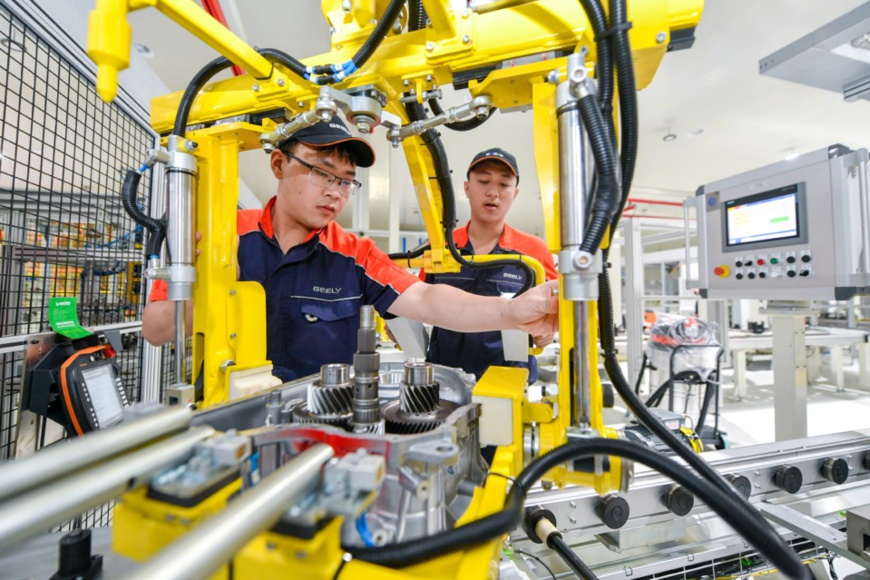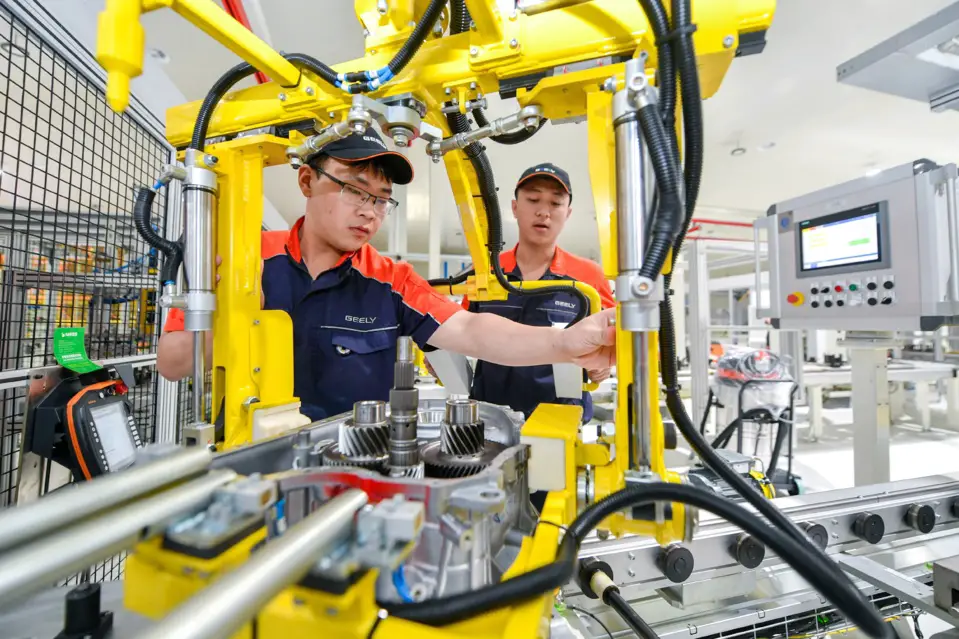By Lin Lili, People's Daily

Wet dual clutch DCT transmissions independently developed by China's automaker Geely are under trial production at the brand's manufacturing base in Changxing, east China's Zhejiang province. Photo by Tan Yunfeng, People's Daily Online
China has witnessed constantly increasing capability of intellectual property (IP) utilization, said Shen Changyu, head of the country's National Intellectual Property Administration (NIPA) at the opening ceremony of the 12th China International Patent Fair on Nov. 11.
In the first 10 months of this year, China's total amount of IP pledge financing hit 166.4 billion yuan (about $25.16 billion), up 35 percent from a year ago, and is likely to exceed 200 billion yuan for the whole year.
In the January-August period, the country's import and export volume of IP royalties reached $29.13 billion, up by 4.2 percent year on year. The export volume was $5.58 billion, an increase of 26.4 percent year on year.
According to the World Intellectual Property Organization (WIPO), China ranked 14th in the 2020 Global Innovation Index among 131 economies, up from the 25th five years ago, and was the only middle-income economy that made it into the top 30. Normally a country is considered an innovative country if it ranks in top 15.
The country has and will never cease its efforts on intellectual property protection (IPR). On Nov. 6, the Forum on International Cooperation in Fighting against IPR Infringement and Counterfeiting was held at the third China International Import Expo (CIIE). Themed with "Innovation, Development, Cooperation," the forum was jointly hosted by the WIPO, State Administration for Market Regulation, and the Leading Group of the National Campaign against IPR Infringements and Counterfeits.
Assistant Director General Minelik Alemu Getahun of the WIPO, on behalf of the WIPO Director General Daren Tang, delivered a speech at the forum via video link. He said China has made remarkable achievements in IPR over the past 40 years, and is gradually becoming a leading innovator of the world.
Progress has been made by the country in multiple key areas of the fight against infringements and counterfeits, as well as IPR protection in 2020.
China's National People's Congress approved the Civil Code and a draft amendment to the Patent Law, implemented the foreign investment law and the regulation on optimizing the business environment, and issued a series of judicial explanation such as the Provisions on Several Issues concerning the Application of Law in Hearing Civil Cases of Trade Secret Infringement. Besides, opinions on strengthening the destruction of infringing and counterfeit goods were jointly released by 9 departments.
The country further enhanced its cross-department and cross-regional law enforcement. Four areas, including the Beijing-Tianjin-Hebei region, Silk Road Economic Zone, Yangtze River Delta and Pan-Pearl River Delta, have carried out in-depth coordination on cracking down upon infringing and counterfeit products.
Relevant department launched various publicity activities on important time nodes such as the World Consumers Rights Day and the World Intellectual Property Day. The National Development and Reform Commission, as well as the People's Bank of China also promoted the construction of a national credit information platform and the "Credit China" website.
As enterprises assume more primary responsibilities and industries play a bigger role of organization, consumers are gaining a stronger sense to reject infringing and counterfeit products.
"IPR is an ecology that combines government, enterprises, social organizations, news media and consumers," said Lu Lili, deputy secretary general of China Council for Brand Development, adding that the ecology will become healthier and more complete under the joint efforts of the society.
CEO Etienne Sanz de Acedo of the International Trademark Association also hailed China's practices, saying the country has made huge efforts on legislation, jurisdiction and administration, and further prevented infringing and counterfeit acts.
Getahun noted that the WIPO will further enhance its IPR cooperation with China, and work with various countries' IP organizations and relevant international organizations to jointly cope with the challenges brought by the COVID-19 pandemic, so as to make innovation a solid foundation for a better future.
In the first 10 months of this year, China's total amount of IP pledge financing hit 166.4 billion yuan (about $25.16 billion), up 35 percent from a year ago, and is likely to exceed 200 billion yuan for the whole year.
In the January-August period, the country's import and export volume of IP royalties reached $29.13 billion, up by 4.2 percent year on year. The export volume was $5.58 billion, an increase of 26.4 percent year on year.
According to the World Intellectual Property Organization (WIPO), China ranked 14th in the 2020 Global Innovation Index among 131 economies, up from the 25th five years ago, and was the only middle-income economy that made it into the top 30. Normally a country is considered an innovative country if it ranks in top 15.
The country has and will never cease its efforts on intellectual property protection (IPR). On Nov. 6, the Forum on International Cooperation in Fighting against IPR Infringement and Counterfeiting was held at the third China International Import Expo (CIIE). Themed with "Innovation, Development, Cooperation," the forum was jointly hosted by the WIPO, State Administration for Market Regulation, and the Leading Group of the National Campaign against IPR Infringements and Counterfeits.
Assistant Director General Minelik Alemu Getahun of the WIPO, on behalf of the WIPO Director General Daren Tang, delivered a speech at the forum via video link. He said China has made remarkable achievements in IPR over the past 40 years, and is gradually becoming a leading innovator of the world.
Progress has been made by the country in multiple key areas of the fight against infringements and counterfeits, as well as IPR protection in 2020.
China's National People's Congress approved the Civil Code and a draft amendment to the Patent Law, implemented the foreign investment law and the regulation on optimizing the business environment, and issued a series of judicial explanation such as the Provisions on Several Issues concerning the Application of Law in Hearing Civil Cases of Trade Secret Infringement. Besides, opinions on strengthening the destruction of infringing and counterfeit goods were jointly released by 9 departments.
The country further enhanced its cross-department and cross-regional law enforcement. Four areas, including the Beijing-Tianjin-Hebei region, Silk Road Economic Zone, Yangtze River Delta and Pan-Pearl River Delta, have carried out in-depth coordination on cracking down upon infringing and counterfeit products.
Relevant department launched various publicity activities on important time nodes such as the World Consumers Rights Day and the World Intellectual Property Day. The National Development and Reform Commission, as well as the People's Bank of China also promoted the construction of a national credit information platform and the "Credit China" website.
As enterprises assume more primary responsibilities and industries play a bigger role of organization, consumers are gaining a stronger sense to reject infringing and counterfeit products.
"IPR is an ecology that combines government, enterprises, social organizations, news media and consumers," said Lu Lili, deputy secretary general of China Council for Brand Development, adding that the ecology will become healthier and more complete under the joint efforts of the society.
CEO Etienne Sanz de Acedo of the International Trademark Association also hailed China's practices, saying the country has made huge efforts on legislation, jurisdiction and administration, and further prevented infringing and counterfeit acts.
Getahun noted that the WIPO will further enhance its IPR cooperation with China, and work with various countries' IP organizations and relevant international organizations to jointly cope with the challenges brought by the COVID-19 pandemic, so as to make innovation a solid foundation for a better future.
 Menu
Menu
 China makes strides in IP protection, application
China makes strides in IP protection, application
















